Improving Flow Discharge-Suspended Sediment Relations: Intelligent Algorithms versus Data Separation
Abstract
:1. Introduction
2. Study Area and Database
2.1. Study Area
2.2. Data and Data Preprocessing
3. Methodology
3.1. Sediment Rating Curve (SRC)
3.2. Optimization Tecnhiques
3.2.1. Conventional Correction Factors
Food and Agriculture Organization (FAO)
Non-Parametric Smearing Estimator (CF2)
3.2.2. Metaheuristic Algorithms
Genetic Algorithm (GA)
- Developing a set of initial random answers; these answers, which are the primary solutions to the problem, are called chromosomes and each one is made up of sets of genes. In the present study, the coefficients a and b in the SRC model are considered as genes and form a chromosome.
- Comparing, ranking, and selecting the best chromosomes; after developing the initial population of chromosomes, to determine its suitability, the efficiency of each chromosome in estimating the suspended sediment must be determined. At this point, using Equation (2) and the values of genes in each chromosome (a and b coefficients), the amount of suspended sediment for the training data is estimated. Then, the suitability of that chromosome using the objective function (root mean squared error (RMSE)) is determined as [57]:where n is the number of training data and Oi and Si are the ith observed and estimated SSC in mg/L, respectively. After determining the suitability of the initial population of chromosomes in the natural selection stage, 50% of the most inefficient chromosomes are removed from the initial population.
- Selecting pairs (parents) for reproduction; at this stage, using selection operators, a pair of chromosomes from the set of primary chromosomes in the previous stage are determined as the parents of the next generation. To accomplish this, the widely used roulette wheel selection method was applied [61]. In fact, in this method, chromosomes with more favorable answers are more likely to be selected.
- Crossover; the production of new and better chromosomes is accomplished to further investigate the solution space (space containing possible coefficients for the SRC model). In this study, the blending method was employed to combine genes in the parent chromosomes and perform the reproduction. In each generation, the number of reproductions was determined by a parameter called the crossover rate.
- Mutation; mutation is a mechanism that leads to a completely random change in the genes of chromosomes (answers to the problem). This prevents the early convergence and getting stuck in local minima, enabling a better search within the answers space.
- Convergence; convergence implies that the GA, by repeating successive generations, is no longer able to find better answers to the problem. There are various ways to stop the genetic algorithm, e.g., the number of repetitions of generations reaching a certain level of error and lack of significant progress in error reduction.
Particle Swarm Optimization (PSO)
- Generation of the initial random population with random positions and velocities, each called a particle (a and b coefficients in the SRC model are assumed to be equivalent to one particle).
- Evaluation of the cost or fitness of each particle; at this stage, the amount of suspended sediment for the training dataset is estimated using Equation (2) and the values for each particle (a and b coefficients). Then, their suitability is evaluated using the objective function (Equation (7)).
- Recording the best position for each particle (pbest) and the best position among all particles (gbest); at this step, each particle moves at a speed that can be adjusted to the search space and retains the best previous position in its memory. In addition, in the total search space, the best gained position by the group is shared with all particles. Each particle in an assumed space is shown as a position and velocity vector. The position of each particle is obtained by comparison between the current position and the best value it has achieved (pbest). Moreover, the best response that each particle has attained so far from the pbest is identified as gbest;
- Updating the position and velocity vector of all particles; in this step, the transition of the particles to new positions is evaluated. In addition, the velocity and position of each particle are corrected by Equations (8) and (9), respectively.where pbest and gbest represent the best personal position and the best position among the entire particles, respectively, t represents the number of iterations, R1 and R2 are learning parameters which determine the movement slope of the local search, and ω is the inertia coefficient.
- Convergence test; this algorithm is repeated for a predetermined number of generations or it is executed until the problem converges to an optimal solution.
Imperialist Competitive Algorithm (ICA)
- Generating the random initial countries (a and b coefficients in the SRC model are assumed equivalent to one country).
- Dividing the countries into two categories based on the objective function of the problem (Equation (7)). Countries with the lowest amounts of objective function are assumed as imperialist and the rest are colonies.
- Determining the number of colonies of each imperialist; to this aim, the power of each imperialist must be evaluated. It is obvious that the stronger the imperialist, the greater the number of its colonies.
- Applying the assimilation policy after the formation of the initial empires; in this algorithm, the assimilation policy is modeled as the movement of colonies towards imperialists.
- Revolution in countries can be considered as a sudden and accidental change in the situation of the colonized countries.
- Comparing the colonies and imperialists (intra-group competition); sometimes a colony, by moving towards an imperialist, reaches a new situation in which it has a lower cost function than the imperialist. In this case, the colony and the imperialist change positions.
- Evaluation of empires (intergroup competition); at this stage, a colony is removed from a weaker empire and transferred to another empire. If the empire has no colony, its imperialist is transferred as a colony to another empire. As a result, during colonial competition, the power of larger empires gradually increases, and weaker empires will be eliminated.
- Finally, continuing the algorithm until the termination condition is observed. The end limit of colonial competition is when we have a single empire in the world with colonies that are very close to the imperialist country in terms of situation.
3.3. Data Separation Techniques
- Seasonal: The measured data for SSC were classified into spring, summer, autumn, and winter [71];
- Discharge classes: Data were divided based on annual average discharge such that in the first category discharge was less than average discharge; in the second category, discharge was ≥the average, but less than twice the average; in the third category, discharge was ≥twice the average [72];
- High water and low water periods: Mean monthly discharge was compared to the mean annual discharge. The months in which mean discharge was ≥ mean annual discharge were considered as the high water period and the months in which the mean discharge was less than the mean annual were considered as the low water period [73];
- Hydrograph state: The daily hydrograph of each water year was plotted and data were classified into three series based on rising and falling limbs or base flow of the hydrograph [23]. Moreover, to assess the effect of these groups on the efficiency of models in estimating suspended sediment, results were compared with a group without data separation (group 5).
3.4. Machine Learning (ML) Model
3.5. Model Evaluation and Comparison
4. Results and Discussion
4.1. Results of the SRC Model Based on Data Separation and Non-Separation
4.2. Results of Optimization of the SRC Using Classical Methods and Metaheuristic Algorithms
4.3. Results of SVR Models with Data Separation and Non-Separation
4.4. Determination of the Best Method of Data Separation
4.5. The Most Effective Model for Estimating SSC
5. Conclusions
Author Contributions
Funding
Institutional Review Board Statement
Informed Consent Statement
Data Availability Statement
Acknowledgments
Conflicts of Interest
References
- Buyukyildiz, M.; Kumcu, S.Y. An estimation of the suspended sediment load using adaptive network based fuzzy inference system, support vector machine and artificial neural network models. Water Resour. Manag. 2017, 31, 1343–1359. [Google Scholar] [CrossRef]
- Sarkar, A.; Sharma, N.; Singh, R. Sediment Runoff Modelling Using ANNs in an Eastern Himalayan Basin, India. In River System Analysis and Management; Springer: Singapore; New York, NY, USA, 2017; pp. 73–82. [Google Scholar]
- Pektaş, A.O.; Doğan, E. Prediction of bed load via suspended sediment load using soft computing methods. Geofizika 2015, 32, 27–46. [Google Scholar] [CrossRef]
- Einstein, H.A. The Bed-Load Function for Sediment Transportation in Open Channel Flows; No. 1026; U.S.D.A Soil Conservation Service: Washington, DC, USA, 1950; p. 74.
- Sivapalan, M.; Takeuchi, K.; Franks, S.; Gupta, V.; Karambiri, H.; Lakshmi, V.; Liang, X.; McDonnell, J.; Mendiondo, E.; O’connell, P. IAHS Decade on Predictions in Ungauged Basins (PUB), 2003–2012: Shaping an exciting future for the hydrological sciences. Hydrol. Sci. J. 2003, 48, 857–880. [Google Scholar] [CrossRef] [Green Version]
- Cao, Z.; Li, Z.; Pender, G.; Hu, P. Non-capacity or capacity model for fluvial sediment transport. Water Manag. 2012, 165, 193–211. [Google Scholar] [CrossRef]
- Cao, Z.; Hu, P.; Pender, G. Reconciled bedload sediment transport rates in ephemeral and perennial rivers. Earth Surf. Process. Landf. 2010, 35, 1655–1665. [Google Scholar] [CrossRef]
- Hu, P.; Tan, L.; He, Z. Numerical Investigation on the Adaptation of Dam-Break Flow-Induced Bed Load Transport to the Capacity Regime over a Sloping Bed. J. Coast. Res. 2020, 36, 1237–1246. [Google Scholar] [CrossRef]
- Cao, Z.; Hu, P.; Pender, G. Multiple time scales of fluvial processes with bed load sediment and implications for mathematical modeling. J. Hydraul. Eng. 2011, 137, 267–276. [Google Scholar] [CrossRef]
- Cao, Z.; Li, Y.; Yue, Z. Multiple time scales of alluvial rivers carrying suspended sediment and their implications for mathematical modeling. Adv. Water Resour. 2007, 30, 715–729. [Google Scholar] [CrossRef]
- Yang, C.T.; Wan, S. Comparisons of selected bed-material load formulas. J. Hydraul. Eng. 1991, 117, 973–989. [Google Scholar] [CrossRef]
- Walling, D. The reliability of rating curve estimates of suspended sediment yield: Some further comments. In Sediment Budgets; IAHS Press: Porto Alegre, Brazil, 1988; pp. 337–350. [Google Scholar]
- Asselman, N. Fitting and interpretation of sediment rating curves. J. Hydrol. 2000, 234, 228–248. [Google Scholar] [CrossRef]
- Tananaev, N.I. Fitting sediment rating curves using regression analysis: A case study of Russian Arctic rivers. Proc. Int. Assoc. Hydrol. Sci. 2015, 367, 193–198. [Google Scholar] [CrossRef]
- Fan, X.; Shi, C.; Zhou, Y.; Shao, W. Sediment rating curves in the Ningxia-Inner Mongolia reaches of the upper Yellow River and their implications. Quat. Int. 2012, 282, 152–162. [Google Scholar] [CrossRef]
- Zeng, C.; Zhang, F.; Lu, X.; Wang, G.; Gong, T. Improving sediment load estimations: The case of the Yarlung Zangbo River (the upper Brahmaputra, Tibet Plateau). Catena 2018, 160, 201–211. [Google Scholar] [CrossRef]
- Jung, B.M.; Fernandes, E.H.; Möller, O.O.; García-Rodríguez, F. Estimating suspended sediment concentrations from River Discharge data for reconstructing gaps of information of long-term variability studies. Water 2020, 12, 2382. [Google Scholar] [CrossRef]
- Ulke, A.; Tayfur, G.; Ozkul, S. Predicting suspended sediment loads and missing data for Gediz River, Turkey. J. Hydrol. Eng. 2009, 14, 954–965. [Google Scholar] [CrossRef] [Green Version]
- Horowitz, A.J. An evaluation of sediment rating curves for estimating suspended sediment concentrations for subsequent flux calculations. Hydrol. Process. 2003, 17, 3387–3409. [Google Scholar] [CrossRef]
- Sadeghi, S.; Mizuyama, T.; Miyata, S.; Gomi, T.; Kosugi, K.; Fukushima, T.; Mizugaki, S.; Onda, Y. Development, evaluation and interpretation of sediment rating curves for a Japanese small mountainous reforested watershed. Geoderma 2008, 144, 198–211. [Google Scholar] [CrossRef]
- Walling, D. Suspended sediment and solid yields from a small catchment prior to urbanization. Fluv. Process. Instrum. Watersheds 1974, 6, 169–192. [Google Scholar]
- Jansson, M.B. Comparison of sediment rating curves developed on load and on concentration. Hydrol. Res. 1997, 28, 189–200. [Google Scholar] [CrossRef]
- Delmas, M.; Cerdan, O.; Cheviron, B.; Mouchel, J.-M. River basin sediment flux assessments. Hydrol. Process. 2011, 25, 1587–1596. [Google Scholar] [CrossRef]
- Ferguson, R. River loads underestimated by rating curves. Water Resour. Res. 1986, 22, 74–76. [Google Scholar] [CrossRef]
- Iadanza, C.; Napolitano, F. Sediment transport time series in the Tiber River. Phys. Chem. Earth Parts A/B/C 2006, 31, 1212–1227. [Google Scholar] [CrossRef]
- Ziegler, A.D.; Benner, S.G.; Tantasirin, C.; Wood, S.H.; Sutherland, R.A.; Sidle, R.C.; Jachowski, N.; Nullet, M.A.; Xi, L.X.; Snidvongs, A. Turbidity-based sediment monitoring in northern Thailand: Hysteresis, variability, and uncertainty. J. Hydrol. 2014, 519, 2020–2039. [Google Scholar] [CrossRef]
- Jansson, M.B. Estimating a sediment rating curve of the Reventazon river at Palomo using logged mean loads within discharge classes. J. Hydrol. 1996, 183, 227–241. [Google Scholar] [CrossRef]
- Sidle, R.C.; Campbell, A.J. Patterns of Suspended Sediment Transport in a Coastal Alaska Stream 1. JAWRA J. Am. Water Resour. Assoc. 1985, 21, 909–917. [Google Scholar] [CrossRef]
- Rodríguez-Blanco, M.; Taboada-Castro, M.; Palleiro, L.; Taboada-Castro, M. Temporal changes in suspended sediment transport in an Atlantic catchment, NW Spain. Geomorphology 2010, 123, 181–188. [Google Scholar] [CrossRef]
- Sidle, R.C. Bed load transport regime of a small forest stream. Water Resour. Res. 1988, 24, 207–218. [Google Scholar] [CrossRef]
- Jones, K.R.; Berney, O.; Carr, D.P.; Barret, E.C. Arid Zone Hydrology for Agricultural Development; FAO Irrigation and Drainage Paper No. 37; FAO: Rome, Italy, 1981. [Google Scholar]
- Duan, N. Smearing Estimate: A Nonparametric Retransformation Method. J. Am. Stat. Assoc. 1983, 78, 605–610. [Google Scholar] [CrossRef]
- Sichingabula, H.M. Factors controlling variations in suspended sediment concentration for single-valued sediment rating curves, Fraser River, British Columbia, Canada. Hydrol. Process. 1998, 12, 1869–1894. [Google Scholar] [CrossRef]
- Collins, A.; Walling, D.; Leeks, G. Use of composite fingerprints to determine the provenance of the contemporary suspended sediment load transported by rivers. Earth Surf. Process. Landf. J. Br. Geomorphol. Group 1998, 23, 31–52. [Google Scholar] [CrossRef]
- Schmidt, K.-H.; Morche, D. Sediment output and effective discharge in two small high mountain catchments in the Bavarian Alps, Germany. Geomorphology 2006, 80, 131–145. [Google Scholar] [CrossRef]
- Sadeghi, S.H.; Saeidi, P. Reliability of sediment rating curves for a deciduous forest watershed in Iran. Hydrol. Sci. J. 2010, 55, 821–831. [Google Scholar] [CrossRef]
- Harrington, S.T.; Harrington, J.R. An assessment of the suspended sediment rating curve approach for load estimation on the Rivers Bandon and Owenabue, Ireland. Geomorphology 2013, 185, 27–38. [Google Scholar] [CrossRef]
- Fang, N.; Shi, Z.; Chen, F.; Zhang, H.; Wang, Y. Discharge and suspended sediment patterns in a small mountainous watershed with widely distributed rock fragments. J. Hydrol. 2015, 528, 238–248. [Google Scholar] [CrossRef]
- Tuset, J.; Vericat, D.; Batalla, R. Rainfall, runoff and sediment transport in a Mediterranean mountainous catchment. Sci. Total Environ. 2016, 540, 114–132. [Google Scholar] [CrossRef] [PubMed]
- Hapsari, D.; Onishi, T.; Imaizumi, F.; Noda, K.; Senge, M. The use of sediment rating curve under its limitations to estimate the suspended load. Rev. Agric. Sci. 2019, 7, 88–101. [Google Scholar] [CrossRef] [Green Version]
- Zhu, Y.-M.; Lu, X.; Zhou, Y. Suspended sediment flux modeling with artificial neural network: An example of the Longchuanjiang River in the Upper Yangtze Catchment, China. Geomorphology 2007, 84, 111–125. [Google Scholar] [CrossRef]
- Melesse, A.; Ahmad, S.; McClain, M.; Wang, X.; Lim, Y. Suspended sediment load prediction of river systems: An artificial neural network approach. Agric. Water Manag. 2011, 98, 855–866. [Google Scholar] [CrossRef]
- Chiang, J.-L.; Tsai, K.-J.; Chen, Y.-R.; Lee, M.-H.; Sun, J.-W. Suspended Sediment Load Prediction Using Support Vector Machines in the Goodwin Creek Experimental Watershed. In Proceedings of the EGU General Assembly Conference Abstracts, Vienna, Austria, 27 April–2 May 2014; p. 5285. [Google Scholar]
- Kumar, D.; Pandey, A.; Sharma, N.; Flügel, W.-A. Daily suspended sediment simulation using machine learning approach. Catena 2016, 138, 77–90. [Google Scholar] [CrossRef]
- Zounemat-Kermani, M.; Kişi, Ö.; Adamowski, J.; Ramezani-Charmahineh, A. Evaluation of data driven models for river suspended sediment concentration modeling. J. Hydrol. 2016, 535, 457–472. [Google Scholar] [CrossRef]
- Khan, M.Y.A.; Tian, F.; Hasan, F.; Chakrapani, G.J. Artificial neural network simulation for prediction of suspended sediment concentration in the River Ramganga, Ganges Basin, India. Int. J. Sediment Res. 2019, 34, 95–107. [Google Scholar] [CrossRef]
- Rezaei, K.; Pradhan, B.; Vadiati, M.; Nadiri, A.A. Suspended sediment load prediction using artificial intelligence techniques: Comparison between four state-of-the-art artificial neural network techniques. Arabian J. Geosci. 2021, 14, 1–13. [Google Scholar] [CrossRef]
- Asadi, H.; Shahedi, K.; Sidle, R.C.; Kalami Heris, S.M. Prediction of Suspended Sediment Using Hydrologic and Hydrogeomorphic Data within Intelligence Models. Iran-Water Resour. Res. 2019, 15, 105–119. [Google Scholar]
- Basturk, B. An artificial bee colony (ABC) algorithm for numeric function optimization. Proceedings of IEEE Swarm Intelligence Symposium, Indianapolis, IN, USA, January 2006. [Google Scholar]
- Schwefel, H.-P. Evolution and Optimum Seeking: The Sixth-Generation; John Wiley & Sons, Inc.: Hoboken, NJ, USA, 1993. [Google Scholar]
- Ketabchi, H.; Ataie-Ashtiani, B. Evolutionary algorithms for the optimal management of coastal groundwater: A comparative study toward future challenges. J. Hydrol. 2015, 520, 193–213. [Google Scholar] [CrossRef]
- Ayvaz, M.T.; Elçi, A. A groundwater management tool for solving the pumping cost minimization problem for the Tahtali watershed (Izmir-Turkey) using hybrid HS-Solver optimization algorithm. J. Hydrol. 2013, 478, 63–76. [Google Scholar] [CrossRef]
- Srinivasan, K.; Kumar, K. Multi-objective simulation-optimization model for long-term reservoir operation using piecewise linear hedging rule. Water Resour. Manag. 2018, 32, 1901–1911. [Google Scholar] [CrossRef]
- Ebtehaj, I.; Bonakdari, H. Assessment of evolutionary algorithms in predicting non-deposition sediment transport. Urban Water J. 2016, 13, 499–510. [Google Scholar] [CrossRef]
- Ebtehaj, I.; Bonakdari, H.; Zaji, A.H.; Gharabaghi, B. Evolutionary optimization of neural network to predict sediment transport without sedimentation. Complex Intell. Syst. 2021, 7, 401–416. [Google Scholar] [CrossRef]
- Gaur, S.; Chahar, B.R.; Graillot, D. Analytic elements method and particle swarm optimization based simulation–optimization model for groundwater management. J. Hydrol. 2011, 402, 217–227. [Google Scholar] [CrossRef]
- Tabatabaei, M.; Jam, A.S.; Hosseini, S.A. Suspended sediment load prediction using non-dominated sorting genetic algorithm II. Int. Soil Water Conserv. Res. 2019, 7, 119–129. [Google Scholar] [CrossRef]
- Tabatabaei, M.; Salehpour Jam, A. Optimization of sediment rating curve coefficients using evolutionary algorithms and unsupervised artificial neural network. Casp. J. Environ. Sci. 2017, 15, 385–399. [Google Scholar]
- Pour, O.M.R.; Shui, L.T.; Dehghani, A.A. Comparision of ant colony optimization and genetic algorithm models for identifying the relation between flow discharge and suspended sediment load (Gorgan River-Iran). Sci. Res. Essays 2012, 7, 3584–3604. [Google Scholar]
- Ebrahimi, H.; Jabbari, E.; Ghasemi, M. Application of Honey-Bees Mating Optimization algorithm on Estimation of Suspended Sediment Concentration. World Appl. Sci. J. 2013, 22, 1630–1638. [Google Scholar]
- Altunkaynak, A. Sediment load prediction by genetic algorithms. Adv. Eng. Softw. 2009, 40, 928–934. [Google Scholar] [CrossRef]
- Yilmaz, B.; Aras, E.; Nacar, S.; Kankal, M. Estimating suspended sediment load with multivariate adaptive regression spline, teaching-learning based optimization, and artificial bee colony models. Sci. Total Environ. 2018, 639, 826–840. [Google Scholar] [CrossRef] [PubMed]
- Choubin, B.; Darabi, H.; Rahmati, O.; Sajedi-Hosseini, F.; Kløve, B. River suspended sediment modelling using the CART model: A comparative study of machine learning techniques. Sci. Total Environ. 2018, 615, 272–281. [Google Scholar] [CrossRef]
- Asadi, H.; Shahedi, K.; Jarihani, B.; Sidle, R.C. Rainfall-runoff modelling using hydrological connectivity index and artificial neural network approach. Water 2019, 11, 212. [Google Scholar] [CrossRef] [Green Version]
- Morgan, R.P.C. Soil Erosion and Conservation; John Wiley & Sons: Hoboken, NJ, USA, 2009. [Google Scholar]
- Holland, J.H. Outline for a logical theory of adaptive systems. J. ACM JACM 1962, 9, 297–314. [Google Scholar] [CrossRef]
- Michalewicz, Z. Genetic Algorithms+Data Structures=Evolution Programs; Springer Science & Business Media: Berlin/Heidelberg, Germany, 2013. [Google Scholar]
- Kennedy, J.; Eberhart, R. Particle swarm optimization. In Proceedings of the ICNN’95—International Conference on Neural, Networks, Perth, WA, Australia, 27 November–1 December 1995; Volume 4, pp. 1942–1948. [Google Scholar]
- Atashpaz-Gargari, E.; Lucas, C. Imperialist competitive algorithm: An algorithm for optimization inspired by imperialistic competition. Proceedings of 2007 IEEE Congress on Evolutionary Computation, Singapore, 25–28 September 2007; pp. 4661–4667. [Google Scholar]
- Bayram, A.; Uzlu, E.; Kankal, M.; Dede, T. Modeling stream dissolved oxygen concentration using teaching–learning based optimization algorithm. Environ. Earth Sci. 2015, 73, 6565–6576. [Google Scholar] [CrossRef]
- Walling, D. Assessing the accuracy of suspended sediment rating curves for a small basin. Water Resour. Res. 1977, 13, 531–538. [Google Scholar] [CrossRef]
- Preston, S.D.; Bierman, V.J., Jr.; Silliman, S.E. An evaluation of methods for the estimation of tributary mass loads. Water Resour. Res. 1989, 25, 1379–1389. [Google Scholar] [CrossRef]
- Hassanzadeh, H.; Bajestan, M.S.; Paydar, G.R. Performance evaluation of correction coefficients to optimize sediment rating curves on the basis of the Karkheh dam reservoir hydrography, west Iran. Arab. J. Geosci. 2018, 11, 1–9. [Google Scholar] [CrossRef]
- Vapnik, V. The nature of statistical learning theory. IEEE Trans. Neural Netw. 1995, 195, 5. [Google Scholar]
- Cristianini, N.; Shawe-Taylor, J. An Introduction to Support Vector Machines and Other Kernel-Based Learning Methods; Cambridge University Press: Cambridge, UK, 2000. [Google Scholar]
- Wang, H.; Xu, D. Parameter selection method for support vector regression based on adaptive fusion of the mixed kernel function. J. Control. Sci. Eng. 2017, 2017, 1–12. [Google Scholar] [CrossRef]
- Chen, S.-T.; Yu, P.-S. Pruning of support vector networks on flood forecasting. J. Hydrol. 2007, 347, 67–78. [Google Scholar] [CrossRef]
- Criss, R.E.; Winston, W.E. Do Nash values have value? Discussion and alternate proposals. Hydrol. Process. An Int. J. 2008, 22, 2723–2725. [Google Scholar] [CrossRef]
- Muleta, M.K. Model performance sensitivity to objective function during automated calibrations. J. Hydrol. Eng. 2012, 17, 756–767. [Google Scholar] [CrossRef]
- Liu, B.; Wang, L.; Jin, Y.-H.; Tang, F.; Huang, D.-X. Improved particle swarm optimization combined with chaos. Chaos Solitons Fractals 2005, 25, 1261–1271. [Google Scholar] [CrossRef]
- Hassan, S. Suspended Sediment Rating Curve for Trigis River Upstream Al-Amarah Barrage. Int. J. Adv. Res 2014, 2, 624–629. [Google Scholar]
- Nhu, V.-H.; Khosravi, K.; Cooper, J.R.; Karimi, M.; Kisi, O.; Pham, B.T.; Lyu, Z. Monthly suspended sediment load prediction using artificial intelligence: Testing of a new random subspace method. Hydrol. Sci. J. 2020, 65, 2116–2127. [Google Scholar] [CrossRef]
- Salih, S.Q.; Sharafati, A.; Khosravi, K.; Faris, H.; Kisi, O.; Tao, H.; Ali, M.; Yaseen, Z.M. River suspended sediment load prediction based on river discharge information: Application of newly developed data mining models. Hydrol. Sci. J. 2020, 65, 624–637. [Google Scholar] [CrossRef]
- Gao, G.; Ning, Z.; Li, Z.; Fu, B. Prediction of long-term inter-seasonal variations of streamflow and sediment load by state-space model in the Loess Plateau of China. J. Hydrol. 2021, 600, 126534. [Google Scholar] [CrossRef]
- Banadkooki, F.B.; Ehteram, M.; Ahmed, A.N.; Teo, F.Y.; Ebrahimi, M.; Fai, C.M.; Huang, Y.F.; El-Shafie, A. Suspended sediment load prediction using artificial neural network and ant lion optimization algorithm. Environ. Sci. Pollut. Res. 2020, 27, 38094–38116. [Google Scholar] [CrossRef] [PubMed]
- Liu, Q.; Zhang, H.; Gao, K.; Xu, B.; Wu, J.; Fang, N. Time-frequency analysis and simulation of the watershed suspended sediment concentration based on the Hilbert-Huang transform (HHT) and artificial neural network (ANN) methods: A case study in the Loess Plateau of China. Catena 2019, 179, 107–118. [Google Scholar] [CrossRef]
- Khosravi, K.; Mao, L.; Kisi, O.; Yaseen, Z.M.; Shahid, S. Quantifying hourly suspended sediment load using data mining models: Case study of a glacierized Andean catchment in Chile. J. Hydrol. 2018, 567, 165–179. [Google Scholar] [CrossRef]
- Rajaee, T.; Mirbagheri, S.A.; Zounemat-Kermani, M.; Nourani, V. Daily suspended sediment concentration simulation using ANN and neuro-fuzzy models. Sci. Total Environ. 2009, 407, 4916–4927. [Google Scholar] [CrossRef] [PubMed]
- Muhammadi, A.; Akbari, G.; Azizzian, G. Suspended sediment concentration estimation using artificial neural networks and neural-fuzzy inference system case study: Karaj Dam. Indian J. Sci. Technol. 2012, 5, 3188–3193. [Google Scholar] [CrossRef]
- Kisi, O.; Haktanir, T.; Ardiclioglu, M.; Ozturk, O.; Yalcin, E.; Uludag, S. Adaptive neuro-fuzzy computing technique for suspended sediment estimation. Adv. Eng. Softw. 2009, 40, 438–444. [Google Scholar] [CrossRef]
- Alp, M.; Cigizoglu, H.K. Suspended sediment load simulation by two artificial neural network methods using hydrometeorological data. Environ. Model. Softw. 2007, 22, 2–13. [Google Scholar] [CrossRef]
- Cobaner, M.; Unal, B.; Kisi, O. Suspended sediment concentration estimation by an adaptive neuro-fuzzy and neural network approaches using hydro-meteorological data. J. Hydrol. 2009, 367, 52–61. [Google Scholar] [CrossRef]
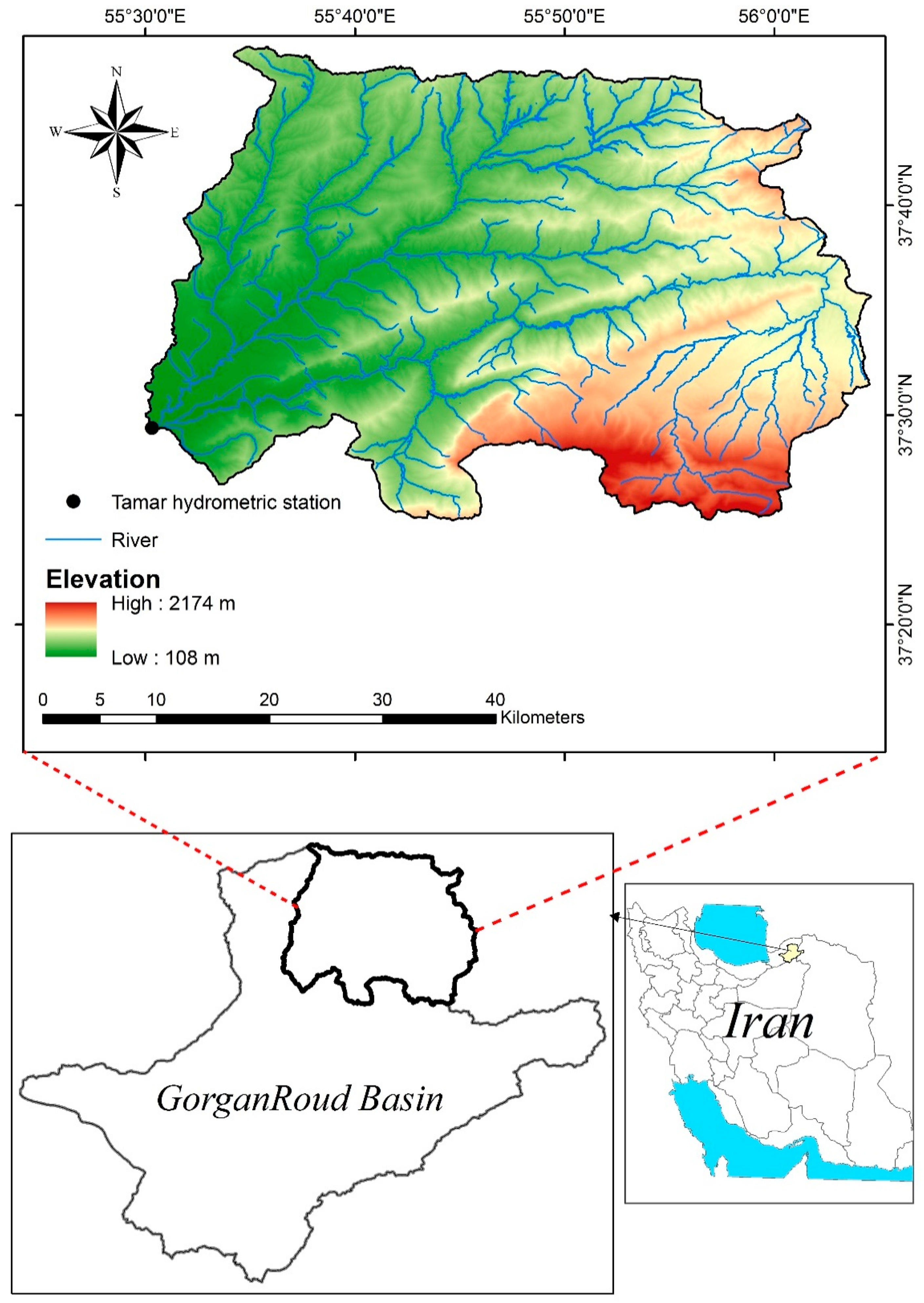
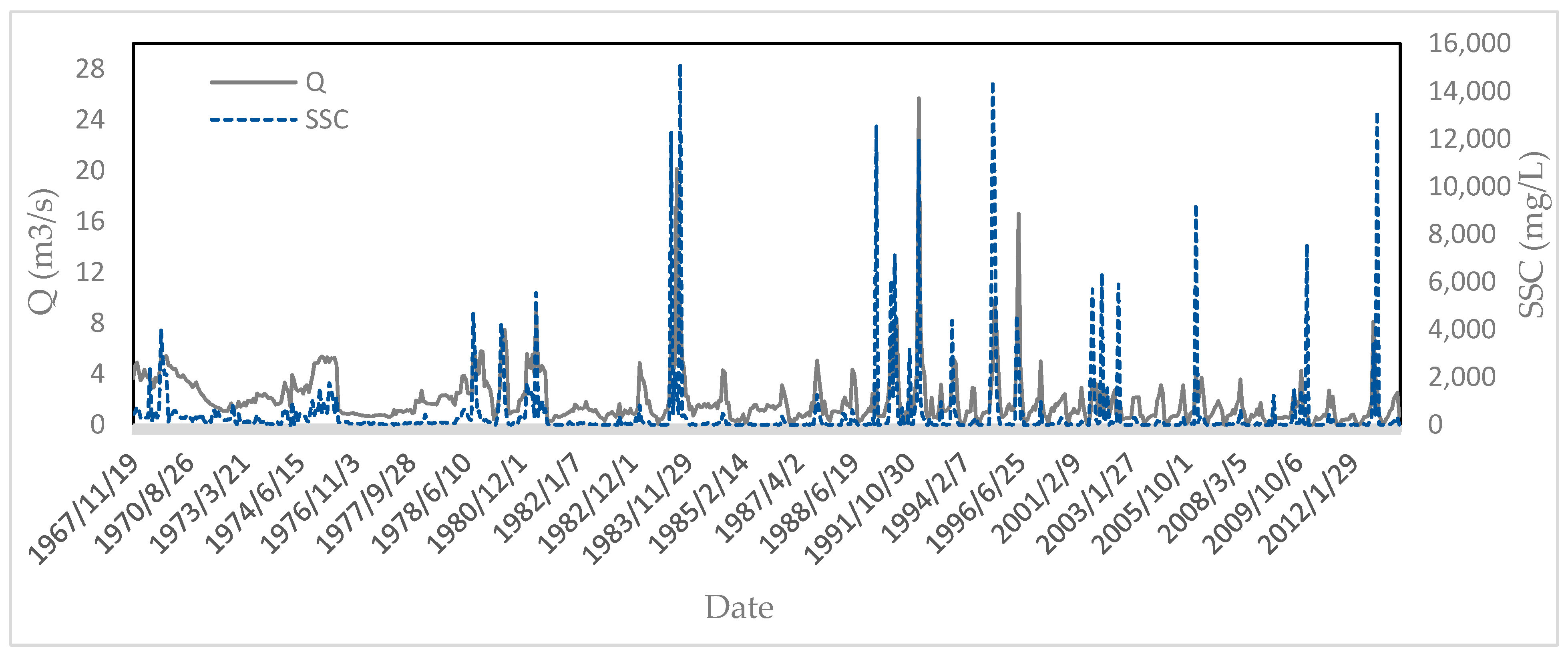
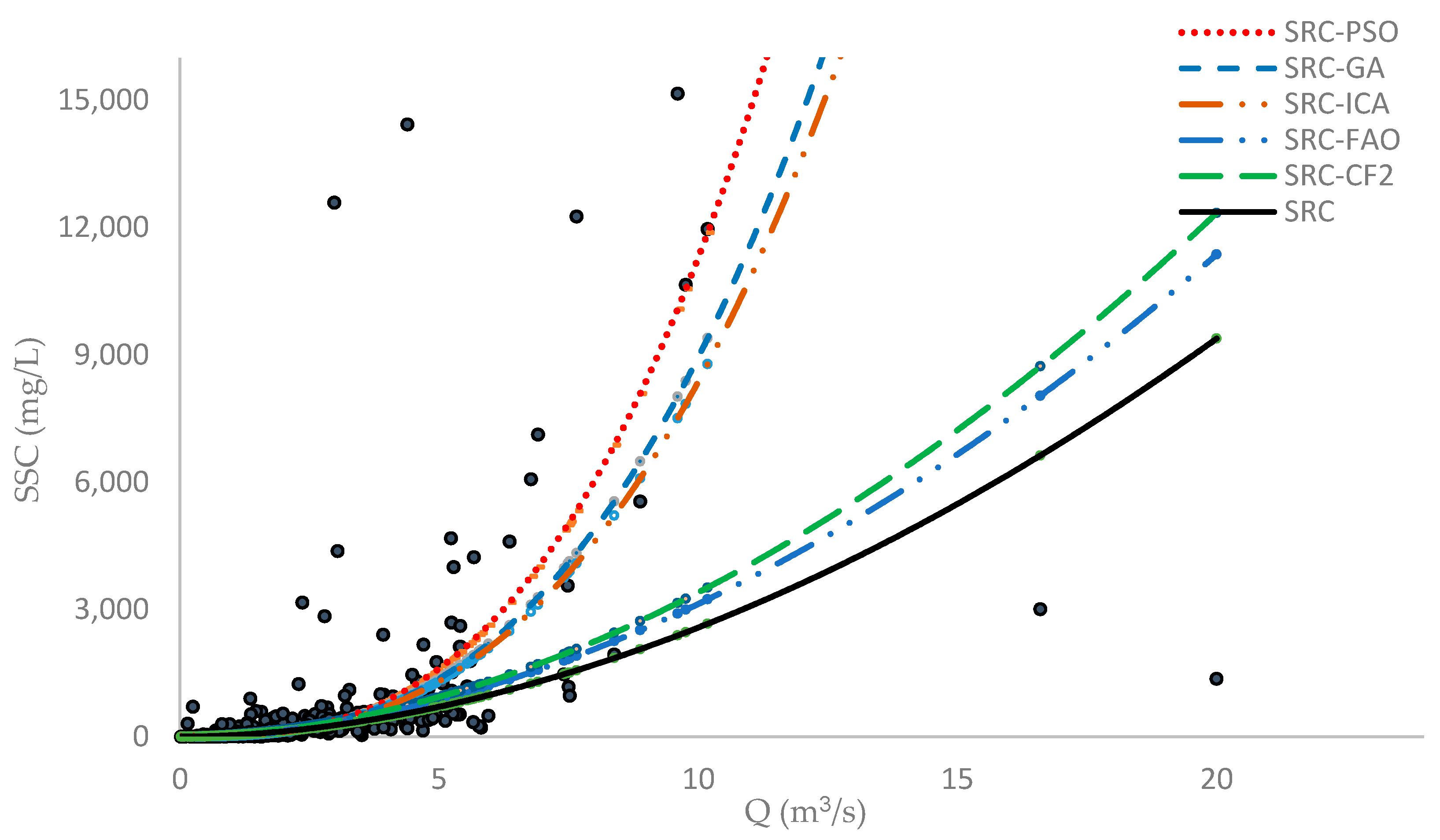
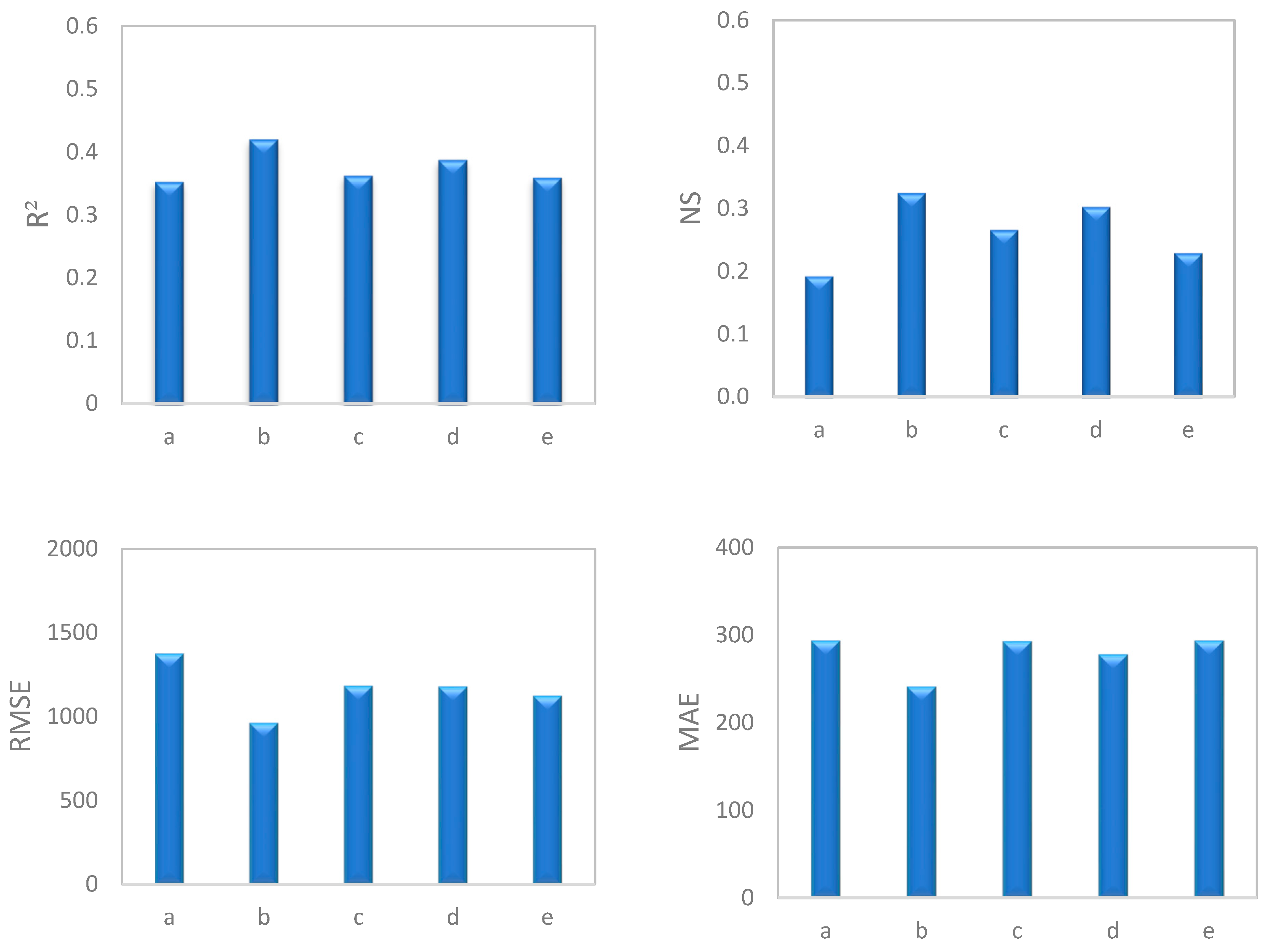
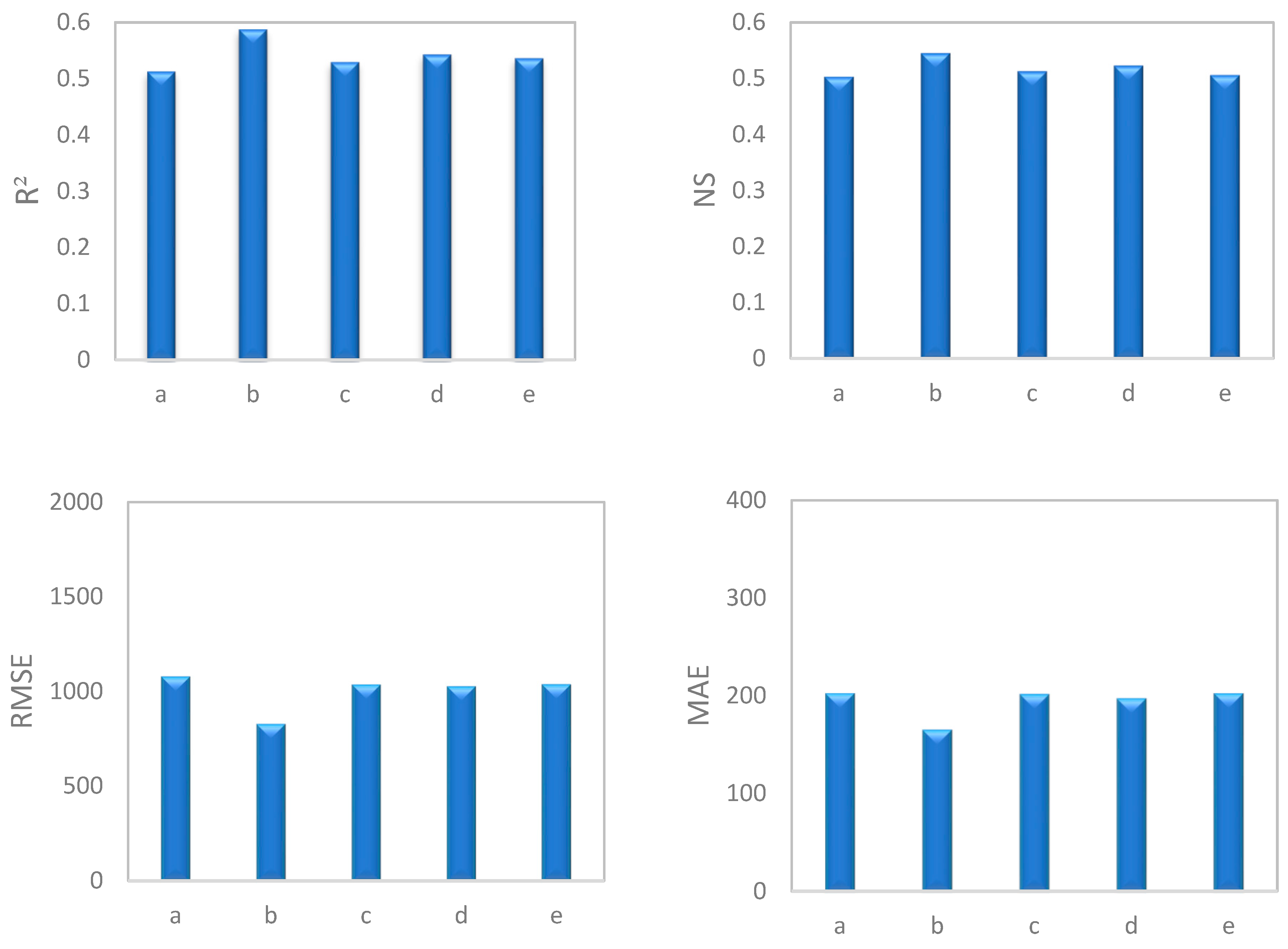
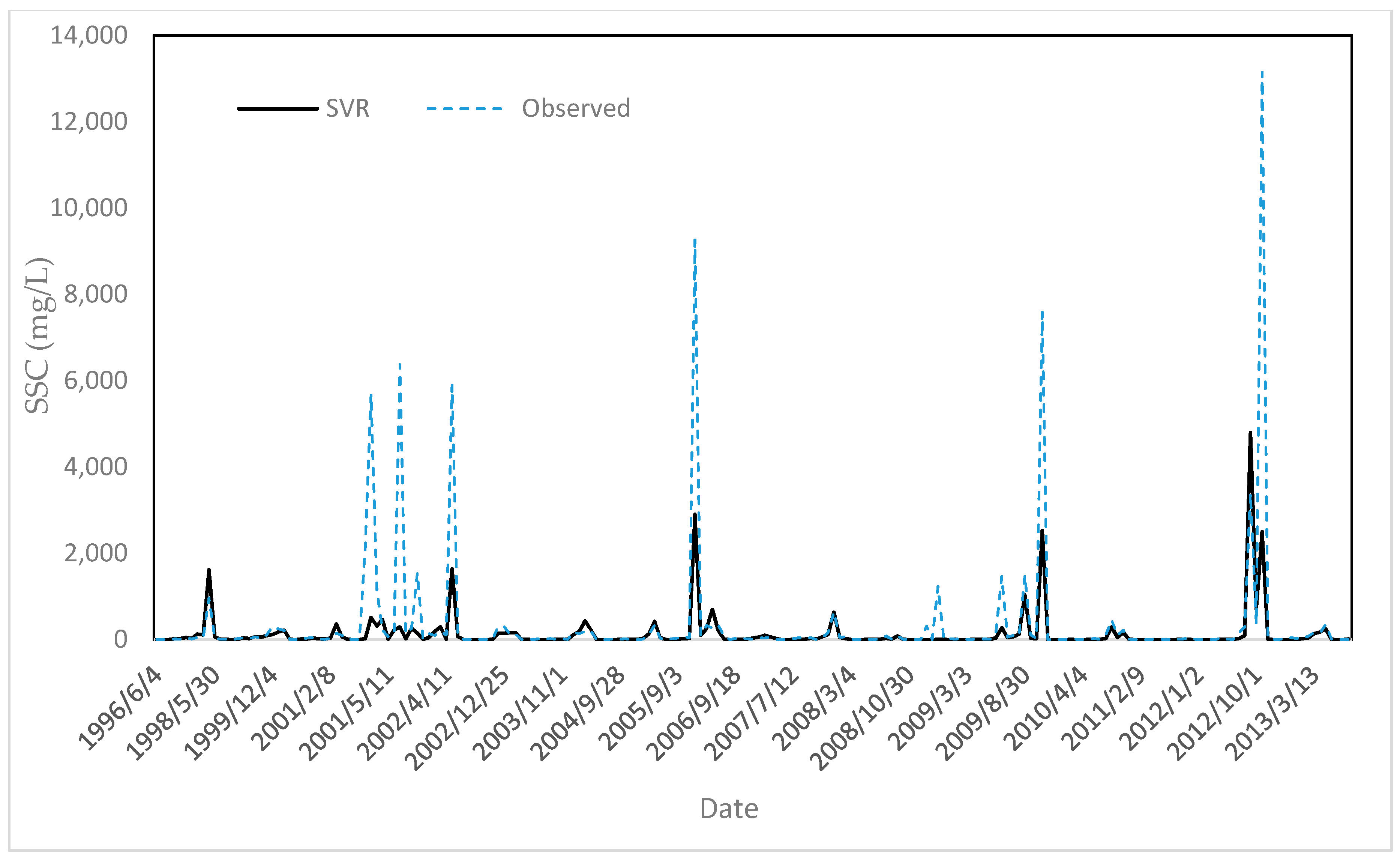
| Variable | ||||||
|---|---|---|---|---|---|---|
| (m3/s) | 0.00 | 25.71 | 1.92 | 2.04 | 4.62 | 1.06 |
| SSC (mg/L) | 0.01 | 15,152.21 | 454.41 | 1556.05 | 6.41 | 3.42 |
| Study Period | Statistical Parameter | ||||||
|---|---|---|---|---|---|---|---|
| Dataset | |||||||
| Entire period | Training | 0 | 25.71 | 2.18 | 1.79 | 1.67 | 480 |
| Testing | 0.02 | 20.13 | 1.17 | 1.06 | 2.22 | 207 | |
| Spring | Training | 0.13 | 25.71 | 2.55 | 1.92 | 1.09 | 177 |
| Testing | 0.32 | 20.13 | 1.09 | 1.08 | 78.2 | 76 | |
| Summer | Training | 0 | 2.98 | 0.46 | 0.56 | 2.39 | 70 |
| Testing | 0.02 | 0.96 | 0.39 | 0.26 | 0.45 | 31 | |
| Autumn | Training | 0.19 | 3.18 | 0.87 | 0.42 | 2.24 | 84 |
| Testing | 0.45 | 2.36 | 1.06 | 0.42 | 0.87 | 36 | |
| Winter | Training | 0.42 | 16.6 | 1.67 | 0.9 | 2.42 | 149 |
| Testing | 0.68 | 10.48 | 2.07 | 1.43 | 2.2 | 64 | |
| Training | 0 | 2.42 | 0.63 | 0.47 | 1.15 | 236 | |
| Testing | 0.02 | 2.3 | 0.96 | 0.44 | 0.31 | 102 | |
| Training | 0.62 | 5.95 | 2.13 | 0.87 | 1.59 | 126 | |
| Testing | 0.84 | 4.44 | 2.04 | 0.93 | 0.83 | 55 | |
| Training | 1.84 | 25.71 | 4.56 | 1.42 | 2 | 117 | |
| Testing | 1.36 | 20.13 | 4.43 | 2.34 | 0.93 | 51 | |
| High water period | Training | 0.07 | 25.71 | 3.1 | 1.95 | 1.3 | 215 |
| Testing | 0.06 | 20.13 | 2.06 | 1.55 | 1.9 | 93 | |
| Low water period | Training | 0 | 5.41 | 1.31 | 1 | 2.01 | 265 |
| Testing | 0.02 | 4.31 | 0.68 | 0.58 | 2.59 | 114 | |
| Rising limb | Training | 0.65 | 25.71 | 2.85 | 1.58 | 1.46 | 142 |
| Testing | 0.72 | 16.6 | 3.26 | 2.28 | 1.43 | 62 | |
| Falling limb | Training | 0.13 | 9.6 | 2.32 | 1.86 | 1.22 | 118 |
| Testing | 0.24 | 7.41 | 1.85 | 1.49 | 1.42 | 51 | |
| Base flow | Training | 0 | 7.65 | 1.17 | 0.88 | 3.75 | 220 |
| Testing | 0.02 | 4.31 | 0.63 | 0.57 | 3.06 | 94 | |
| Study Period | Statistical Parameter | ||||||
|---|---|---|---|---|---|---|---|
| Dataset | |||||||
| Entire period | Training | 0.13 | 15,152.21 | 497.17 | 1602.92 | 6.84 | 480 |
| Testing | 0.01 | 13,152.13 | 354.83 | 1439.82 | 6.16 | 207 | |
| Spring | Training | 0.39 | 15,152.21 | 944.54 | 2342.31 | 5.02 | 191 |
| Testing | 4.22 | 7585.72 | 278.85 | 1080.45 | 6.17 | 82 | |
| Summer | Training | 0.01 | 6583.52 | 162.99 | 1080.19 | 5.43 | 56 |
| Testing | 0.17 | 444.88 | 69.09 | 111.95 | 1.45 | 25 | |
| Autumn | Training | 0.14 | 5894.95 | 273.23 | 1096.45 | 4.61 | 84 |
| Testing | 0.92 | 2140.45 | 103.51 | 326.98 | 4.90 | 36 | |
| Winter | Training | 1.93 | 12,256.62 | 293.73 | 1334.35 | 7.51 | 149 |
| Testing | 5.52 | 6065.7 | 597.12 | 1286.53 | 2.80 | 64 | |
| Training | 0.01 | 7585.72 | 92.2 | 709.85 | 10.59 | 264 | |
| Testing | 0.13 | 2140.45 | 67.24 | 167.42 | 8.38 | 114 | |
| Training | 0.14 | 13,152.13 | 1257.3 | 3357.62 | 3.51 | 126 | |
| Testing | 4.22 | 12,583.52 | 379.23 | 1257.41 | 8.00 | 55 | |
| Training | 34.77 | 15,152.21 | 1159.2 | 2140.72 | 4.92 | 90 | |
| Testing | 59.82 | 11,964.84 | 1697.5 | 2797.51 | 2.54 | 38 | |
| High water period | Training | 0.14 | 15,152.21 | 611.06 | 2028.42 | 6.35 | 215 |
| Testing | 0.39 | 13,152.13 | 884.83 | 2270.51 | 4.57 | 93 | |
| Low water period | Training | 0.01 | 8231.67 | 264.22 | 1257.81 | 5.91 | 265 |
| Testing | 0.13 | 3996.55 | 147.39 | 413.62 | 6.40 | 114 | |
| Rising limb | Training | 5.5 | 14,426.4 | 1387.2 | 2910.18 | 3.07 | 142 |
| Testing | 6.73 | 4673.56 | 462.44 | 733.04 | 3.4 | 62 | |
| Falling limb | Training | 0.39 | 15,152.21 | 646.2 | 2566.84 | 5.73 | 118 |
| Testing | 0.79 | 13,152.13 | 473.59 | 1537.42 | 8.02 | 51 | |
| Base flow | Training | 0.01 | 12,583.52 | 288.15 | 1386.16 | 7.2 | 220 |
| Testing | 0.13 | 8231.67 | 135.81 | 955.45 | 9.47 | 94 | |
| Group | Study Period | Equation | a | b |
|---|---|---|---|---|
| Without any separation (a) | Entire period | 35.04 | 1.86 | |
| Spring | 34.43 | 1.97 | ||
| Seasonal (b) | Summer | 32.88 | 1.36 | |
| Autumn | 29.51 | 1.81 | ||
| Winter | 17.45 | 2.66 | ||
| 31.69 | 1.48 | |||
| Discharge Classes (c) | 15.92 | 2.8 | ||
| 11.29 | 2.69 | |||
| High water-low water periods (d) | High water period | 25.46 | 2.18 | |
| Low water period | 35.21 | 1.69 | ||
| Rising limb | 22.64 | 2.31 | ||
| Hydrograph State (e) | Falling limb | 60.58 | 1.54 | |
| Base flow | 27.94 | 1.69 |
| Model | Study Period | RMSE (mg/L) | NS | MAE (mg/L) | R2 |
|---|---|---|---|---|---|
| without any separation | Entire period | 1366.96 | 0.19 | 292.23 | 0.35 |
| Spring | 1093.17 | 0.31 | 279.18 | 0.36 | |
| Seasonal | Summer | 683.8 | 0.20 | 201.08 | 0.31 |
| Autumn | 1083.25 | 0.34 | 219.17 | 0.41 | |
| Winter | 950.22 | 0.44 | 258.69 | 0.59 | |
| 1118.38 | 0.29 | 267.99 | 0.40 | ||
| Discharge Classes | 1148.47 | 0.26 | 275.73 | 0.36 | |
| 1255.92 | 0.24 | 330.71 | 0.32 | ||
| High water/low water periods | High water period | 1189.56 | 0.27 | 287.07 | 0.36 |
| Low water period | 1151.44 | 0.33 | 265.54 | 0.41 | |
| Rising limb | 926.33 | 0.30 | 232.77 | 0.45 | |
| Hydrograph State | Falling limb | 1310.15 | 0.13 | 399.12 | 0.24 |
| Base flow | 1109.78 | 0.25 | 244.75 | 0.38 |
| Model Name | Equation | RMSE (mg/L) | NS | MAE (mg/L) | R2 |
|---|---|---|---|---|---|
| SRC | 1366.96 | 0.19 | 292.23 | 0.34 | |
| SRC-FAO | 1345.72 | 0.25 | 289.1 | 0.35 | |
| SRC-CF2 | 1335.75 | 0.29 | 288.2 | 0.36 | |
| SRC-PSO | 1099.91 | 0.44 | 236.95 | 0.45 | |
| SRC-GA | 1113.31 | 0.41 | 245.84 | 0.43 | |
| SRC-ICA | 1127.92 | 0.40 | 250.07 | 0.42 |
| Model | Study Period | SVR | ||
|---|---|---|---|---|
| C | ε | |||
| without any separation | Entire period | 2.5 | 1 | 0.1 |
| Spring | 0.3 | 5 | 0.001 | |
| Seasonal | Summer | 2 | 2.5 | 0.0001 |
| Autumn | 0.4 | 5 | 0.001 | |
| Winter | 0.1 | 1 | 0.01 | |
| 0.15 | 1 | 0.1 | ||
| Discharge Classes | 0.1 | 3.5 | 0.001 | |
| 0.17 | 5 | 0.01 | ||
| High water-low water periods | High water period | 2 | 2.5 | 0.1 |
| Low water period | 0.1 | 1 | 0.01 | |
| Rising limb | 0.21 | 1 | 0.01 | |
| Hydrograph State | Falling limb | 0.1 | 1.5 | 0.1 |
| Base flow | 0.1 | 5 | 0.0001 | |
| Model | Study Period | RMSE (mg/L) | NS | MAE (mg/L) | R2 |
|---|---|---|---|---|---|
| without any separation | Entire period | 1069.89 | 0.50 | 201.09 | 0.52 |
| Spring | 1063.77 | 0.52 | 199.19 | 0.55 | |
| Seasonal | Summer | 461.86 | 0.41 | 101.77 | 0.45 |
| Autumn | 957.84 | 0.56 | 185.5 | 0.63 | |
| Winter | 796.17 | 0.68 | 167.85 | 0.71 | |
| 970.86 | 0.55 | 182.83 | 0.56 | ||
| Discharge Classes | 1023.99 | 0.52 | 200.08 | 0.54 | |
| 1088.75 | 0.46 | 217.38 | 0.48 | ||
| High water—low water periods | High water period | 1106.5 | 0.51 | 201.63 | 0.53 |
| Low water period | 929.72 | 0.53 | 189.78 | 0.55 | |
| Rising limb | 911.29 | 0.57 | 171.63 | 0.59 | |
| Hydrograph State | Falling limb | 1119.2 | 0.38 | 237.3 | 0.43 |
| Base flow | 1059.23 | 0.56 | 193.46 | 0.58 |
Publisher’s Note: MDPI stays neutral with regard to jurisdictional claims in published maps and institutional affiliations. |
© 2021 by the authors. Licensee MDPI, Basel, Switzerland. This article is an open access article distributed under the terms and conditions of the Creative Commons Attribution (CC BY) license (https://creativecommons.org/licenses/by/4.0/).
Share and Cite
Asadi, H.; Dastorani, M.T.; Sidle, R.C.; Shahedi, K. Improving Flow Discharge-Suspended Sediment Relations: Intelligent Algorithms versus Data Separation. Water 2021, 13, 3650. https://doi.org/10.3390/w13243650
Asadi H, Dastorani MT, Sidle RC, Shahedi K. Improving Flow Discharge-Suspended Sediment Relations: Intelligent Algorithms versus Data Separation. Water. 2021; 13(24):3650. https://doi.org/10.3390/w13243650
Chicago/Turabian StyleAsadi, Haniyeh, Mohammad T. Dastorani, Roy C. Sidle, and Kaka Shahedi. 2021. "Improving Flow Discharge-Suspended Sediment Relations: Intelligent Algorithms versus Data Separation" Water 13, no. 24: 3650. https://doi.org/10.3390/w13243650






